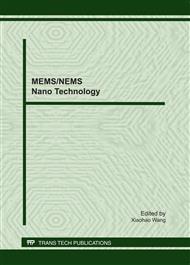[1]
P.L. Kapitza, Zh. Eksp. Teor. Fiz. 11, 1 {J. Phys. (USSR) 4 (1941) 181}.
Google Scholar
[2]
Little, W.A., 1959, Can. J. Phys. 37, pp.334-349.
Google Scholar
[3]
Swartz, E.T., and Pohl, R. O, Rev. Mod. Phys., 1989, 61, p.605–668.
Google Scholar
[4]
Snyder, N.S., 1970, Cryogenics, 10, p.89–95.
Google Scholar
[5]
Hopkins, P.E., and Norris, P.M., 2007, 11, p.247–257.
Google Scholar
[6]
Hopkins, P.E., and Norris, P.M., 2009, ASME J. Heat Transfer, 131, p.022402.
Google Scholar
[7]
Stoner, R.J., and Maris, H.J., 1993, Phys. Rev. B, 48, p.16373–16387.
Google Scholar
[8]
Lyeo, H.K., and Cahill, D.G., 2006, Phys. Rev. B, 73, p.144301.
Google Scholar
[9]
Inous R, Thanka h, nakanishi k., The Journal of Chemical Physics, 1996, 104: 9569-9577.
Google Scholar
[10]
Maiti A, Mahan G D, Pantelides S T., Solid State Communications, 1997, 102(7): 517-521.
Google Scholar
[11]
Lee, S.M., Matamis, G., Cahill, D. G, and Allen W.P., Microscale Thermophysical Engineering, 2-1(1998), 31-36.
Google Scholar
[12]
Maruyama S, Kimura T., Thermal Science & Engineering, 1999, 7(1): 63-68.
Google Scholar
[13]
Twu J, Ho J R., Physical Review B, 2003, 67(20): 205422(8).
Google Scholar
[14]
S.H. Choi, The University of Tokyo, (2003).
Google Scholar
[15]
S.H. Choi, S. Maruyama, in: Proc. of 40th Natinoal Heat Transfer Symp. of Japan. (2003).
Google Scholar
[16]
S.H. Choi, S. Maruyama, International Journal of Thermal Science 44(2005)547-558.
Google Scholar
[17]
P.E. Hopkins, P.M. Norris, and R. J. Stevens, J., Heat Transfer 130, 022401_2008.
Google Scholar
[18]
P.J. Hegedis. A. R. Abramson, International Journal of Heat and Mass Transfer 49(2006) 4921-4931.
Google Scholar
[19]
R.J. Stevens, Lenonid V. Zhigilei, Pamela M. Norris, International Journal of Heat and Mass Transfer 50(2007)3977-3989.
Google Scholar
[20]
J W Lyver IV and E Blaisten-Barojas, J. Phys.: Condens. Matter 21 (2009) 345402 (8pp).
DOI: 10.1088/0953-8984/21/34/345402
Google Scholar
[21]
Schelling P K, Phillpot S R., Journal of Applied Physics, 2003, 93(9): 5377-5387.
Google Scholar
[22]
B. Hafskjold, S.K. Ratkje, J. Stat. Phys. 78 (1995)463.
Google Scholar
[23]
H. Kaburaki, J. Li.S. Yip, Mater. Res. Soc. Symp. Proc. 538(1998) 503.
Google Scholar
[24]
CHOISH, MARUYAMAS, KIMKK, et al., J Korean Phys Soc, 2003, 43: 747-753.
Google Scholar


